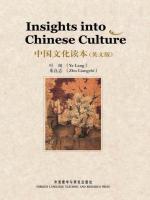书评
用户823540
Insights into Chinese Culture serves as a profound portal, unveiling the
rich and intricate layers of Chinese culture. Among its diverse
explorations, the depiction of old Shanghai stands out as a captivating
microcosm, vividly illustrating the complex interplay between modernity
and tradition, as well as the seamless convergence of Chinese and
foreign cultures. Shikumen buildings, the iconic architectural gems of
old Shanghai, were more than mere structures; they were living
testaments to the city's historical and cultural evolution. These
buildings housed a diverse array of residents, from office clerks and
industrial workers to artists, playwrights, and musicians. In the 1920s,
renowned figures like Lu Xun, Mao Dun, Ba Jin, Xu Beihong, and Liu Haisu
found shelter and inspiration within their walls, with some even
dwelling in the humble garrets. These small, sun - deprived spaces, cold
in winter and sweltering in summer, became crucibles of creativity,
nurturing the literary and artistic endeavors that would shape modern
Chinese culture. The Shikumen's design itself was a blend of Chinese and
Western influences. While the exterior retained traditional Chinese
elements, the layout and functionality often incorporated Western
architectural concepts, symbolizing Shanghai's openness to external
influences while maintaining its cultural roots. The alleys, or
lilong/longtang, formed by these Shikumen buildings were the heart of
ordinary Shanghai life. Ranging from four meters to less than three
meters in width, these narrow thoroughfares witnessed every aspect of
daily existence, from eating and washing to cleaning vegetables and
emptying night - stools. In summer, the alleys transformed into communal
spaces, with families sharing meals outdoors and enjoying the evening
breeze on reclining chairs. The openness of alley life meant little
privacy; everyone knew their neighbors' affairs. Paradoxically, this
lack of privacy may have fostered the open - mindedness of Shanghai
people, a trait that would later aid in embracing foreign cultures. The
alleys were also bustling commercial hubs, lined with small shops and
filled with vendors selling southern - style snacks like steaming wonton
soup, ham zongzi, and sweet rice porridge. The unique interaction
between vendors and residents, such as using baskets to buy snacks from
upper - floor windows, demonstrated the city's adaptability and the
harmonious blend of convenience and tradition. Despite this seemingly
insular daily life, old Shanghai was far from isolated from Western
modernity. Middle - class and intellectual residents, especially
writers, frequented foreign - language bookstores, eager to access the
latest Western publications. Ye Lingfeng's purchase of James Joyce's
Ulysses is a prime example. His willingness to pay 70 cents for a book
worth 10 US dollars highlighted the intellectual curiosity of Shanghai's
residents and their deep connection to global cultural trends. Even
while living in traditional Shikumen buildings, their thoughts and
tastes were being subtly shaped by Western ideas, creating a fascinating
tension between tradition and modernity. This tension found a new
expression at the turn of the 21st century with the creation of
Xintiandi. Renovated from Shikumen alleys, this entertainment resort
preserved the external black bricks and paths, paying homage to the
city's past. Inside, however, modern cafes, restaurants, music bars,
fashion outlets, and movie theaters catered to contemporary lifestyles.
Xintiandi became a cultural phenomenon, appealing to all. As the saying
goes, “The aged feel nostalgic, the young feel fashionable, foreign
visitors feel very Chinese, and Chinese people see it as Western style.”
It was a perfect example of Shanghai's ability to blend modernity and
tradition, creating something both original and fashionable. In
conclusion, the portrayal of old Shanghai in Insights into Chinese
Culture offers a rich and detailed view of a city at the crossroads of
cultures. Shikumen buildings and their alleys, the daily life within,
and the transformation into modern spaces like Xintiandi all illustrate
how Shanghai thrived on its openness and adaptability. This cosmopolitan
city, as depicted in the book, serves as a microcosm of the broader
Chinese cultural landscape, where past and present, local and global,
constantly interact and evolve. The book effectively captures these
nuances, providing readers with a deeper understanding of the complexity
and richness of Chinese culture.



 京公网安备 11010802032529号
京公网安备 11010802032529号